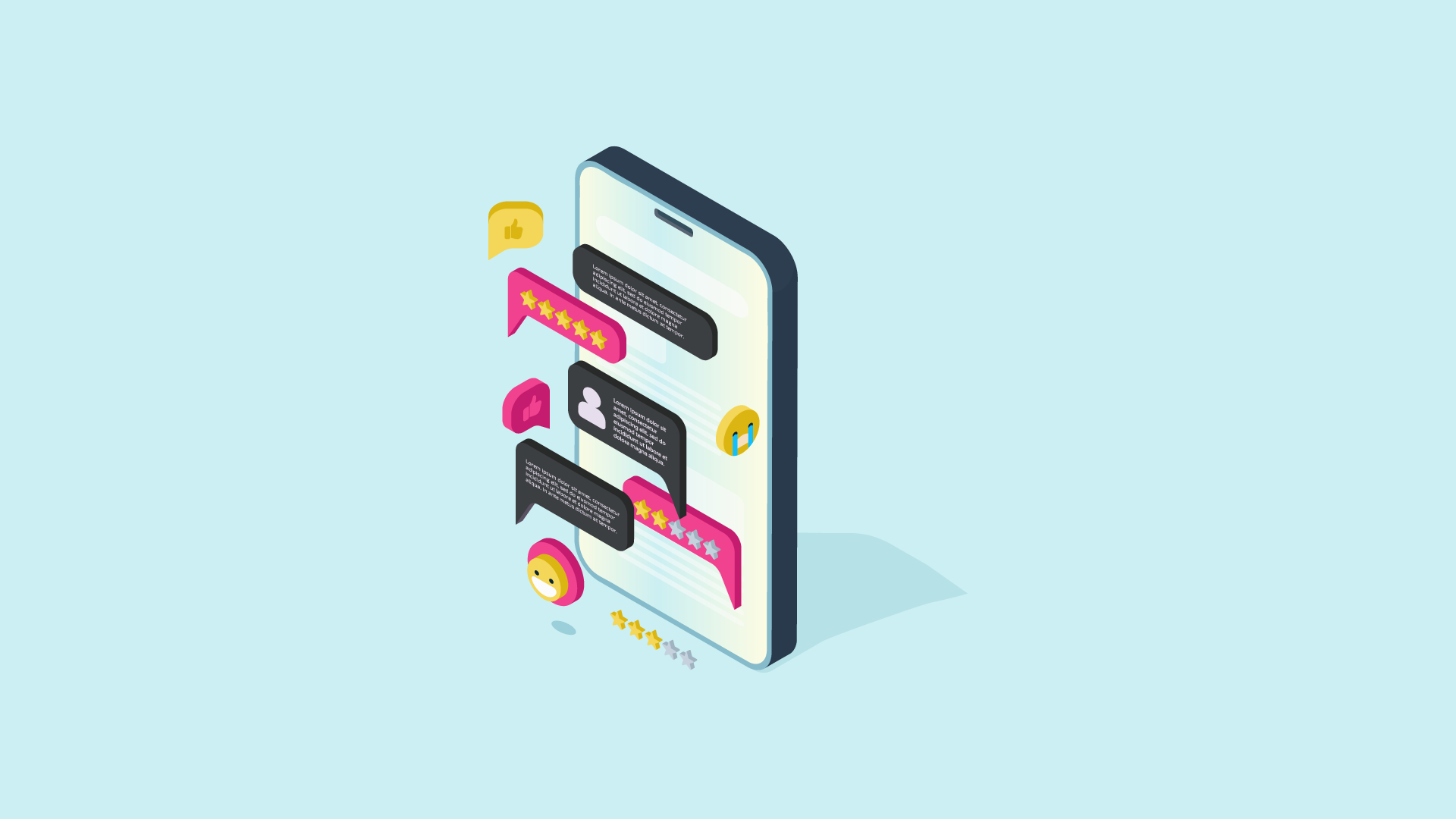Conversational marketing is a new way of thinking about how we interact with our customers. It's not just about selling products anymore; it's about building relationships with your audience.
In this post, I'm going to share examples of conversational marketing in practice. These examples will help you understand why conversational marketing works, and how you can apply it to your own business.
I've also included a few tips for using conversational marketing effectively in your own business.
|
Conversational Marketing |
What Is Conversational Marketing?
Conversational commerce is a new way for companies to interact with their customers online. It uses the power of one-on-one conversations to move customers through the buying cycle, similar to a real-time conversation.
It means that it's an automated dialogue with your website visitors. You can ask different types of questions depending on their previous answers, which allows you to get specific information about them.
It makes sense if you want to achieve the results you desire. At the same time, it works when people are engaging with your company.
Conversational marketing is effective because it helps companies create meaningful connections with their customers by converting them into leads instead of having them fill out long-form surveys.
And it's been shown to be an effective way to increase user engagement. It can help you attract new customers, retain existing ones, and grow your business.
By making it easier for prospects to engage with your business, you can increase the number of qualified prospects who reach out to you. This means that conversational marketing isn't just bringing you new customers; it's bringing you qualified prospects as well.
Conversational Marketing Examples
Conversational marketing is a much more human approach to gathering data from website visitors.
Instead of asking them to complete lengthy forms or filling up pages with text boxes, you can use natural language processing (NLP) to understand what they're looking for and then provide relevant content in response.
This type of marketing has become increasingly popular over the past few years. Here are some examples of how companies are using conversational marketing:
1. HubSpot
HubSpot allowed people to signup for its Four Days of Facebook Campaign through multiple channels, including Facebook Messenger. Users loved the conversational UI and were quick to encourage their friends and coworkers to sign up as well.
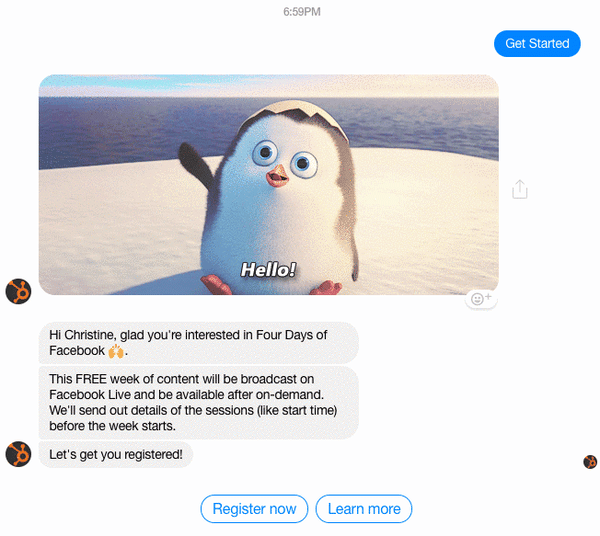
And success wasn't simply about making sure that everyone registered for the live event. Messenger was the highest converting channel of new product registrations to HubSpot Marketing Free through the campaign.
2. HealthTap
HealthTap is a healthcare company that wants to make healthcare more accessible for everyone. To do so, they created a Facebook messenger bot called "HealthTap."
After installing the app, HealthTap asks you to ask any health question. Once you ask one, the app analyzes your request and displays popular answers to similar requests.
By clicking ‘See answer' you can even see which doctors have answered questions for each topic, and read their detailed responses.
You can ask any questions you want, but if the answers aren't quite what you're looking for, you can get them answered by a real doctor within a day. If you don’t want to spend time waiting 24 hours, click the ‘Get answers now' button to access HealthTap’s premium health consulting services. You can contact a doctor within minutes for just $25.
This chatbot demonstrates how businesses can answer customer questions in real-time, at scale, and at low cost, even providing an excellent opportunity for upselling once you've shown your value.
For some people, health is a personal issue and they need one-on-one interaction with a physician or healthcare professional. Busy schedules and high demands often mean that it's hard to get this kind of personalized attention. That's why Healthtap’s app is so good at conversational advertising.
If it wasn't for the obvious links, one would be led to believe that they're receiving actual advice from a real doctor when they see the "real" doctor's name at the top of the page. The way the conversation flows between the user and the bot feels similar to a real conversation. When you add in the fact that the bot can connect you to a human if needed, you've got the perfect storm for excellent customer service.
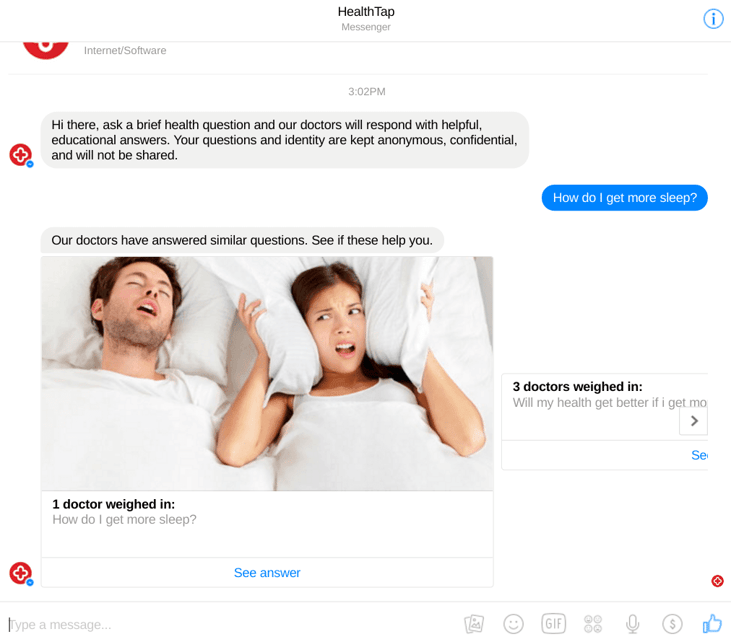
3. RapidMiner
RapidMiner is an excellent example of how to successfully implement a chatbot to scale conversation and eliminate the noise to uncover the best prospects.
RapidMiner made the bold move by replacing their traditional lead-capturing forms with a chatbot from Drift, which was built specifically for them.
It was obvious that they couldn't afford to speak to every visitor, and shouldn't waste their valuable resources trying to reach out to them. Instead, they should focus on the conversations with the visitors who were most likely to purchase.
RapidMiner was capable of finding those individuals through its intelligent LeadBot, which enabled it to automate the lead qualification processes by posing the same qualifying questions your Sales Team would pose.
Qualified prospects were then automatically scheduled for meetings with sales reps, relieving them of the burden of qualifying leads themselves.
By incorporating a more personal, conversational user interface into their web page, RapidMiner was able to engage and evaluate almost every visitor to their website.
Since switching to an intelligent LeadBot, they've helped capture 4,000 leads, adding $1 million into their sales pipelines and helping everyone, even those who aren't necessarily looking to buy.
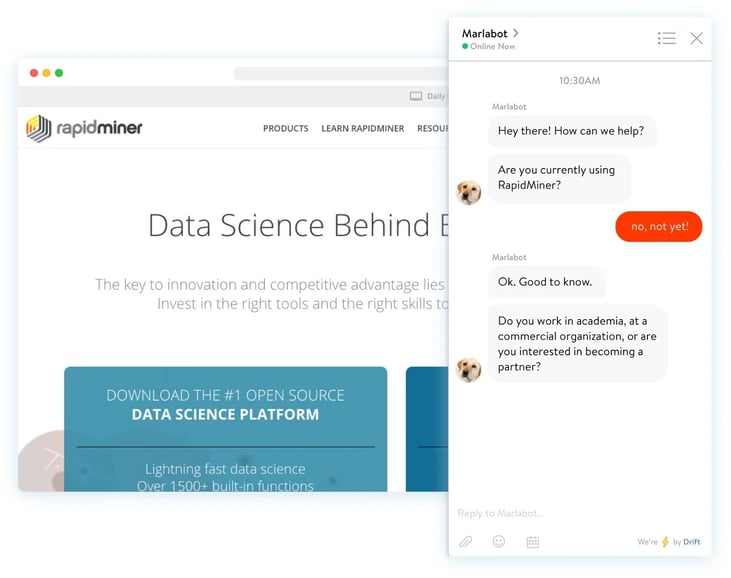
4. Databox
Databox makes sure its lead prospects know they have someone to talk to by creating an entire sidebar on their home page for their chatbot.
Relationships start building right away and lead qualification happens faster because of the features. Users can choose a pre-written question for a conversation or type one of their own.
5. Spring
Do you need an online personal shopping assistant? This may be every woman's dream, and spring has made it come true.
Spring's shopper robot isn't the kind that has conversations but believe me, it doesn't require them.
Every conversation with the chat robot starts with a series of questions designed to help you focus on just one topic at a time.
After narrowing down your product idea, you define your price point and, just like that Spring recommends products from different brands across the internet.
Using a bot to help you buy things online means that you’ll be able to get the items you want faster than if you were doing it yourself.
Many online stores have a huge inventory of items that can take visitors away from the shopping cart page for long periods, but this brings conversations and personalization back into their experiences. It saves shoppers' search times and creates an illusion of one-on‑one customer service that is often lost in online shopping.
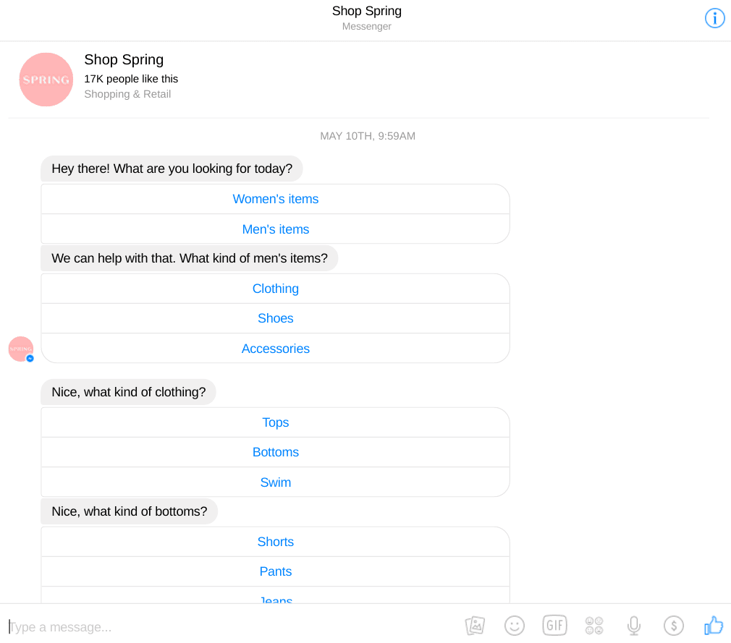
6. eBay
eBay has developed an extremely sophisticated eCommerce chatbot, which is also one of the most popular ones out there.
This chatbot is special because it was designed specifically for Google Assistant, so you can only use it with your Google Home or your Android phone by using voice commands.
Like Spring, this bot allows its user to navigate through a large variety of products, but this time, they're able to do so only by voice.
You just need to say, "Ok Google, let me speak with eBay," and then bam, you're on your path to endless eBay shopping.
The bot quickly searches for the best deals for what you asked for and sends them to your phone so you can easily purchase them.
This is an excellent example of how to use conversational marketing with voice searches.
The ease of the spoken conversation makes it appear like there might be a real person on your side getting you what you need, but don't count on it.
As Amazon Alexa, Siri, et al become even more popular, they’ll drive further adoption and usage of voice-based conversational marketing.
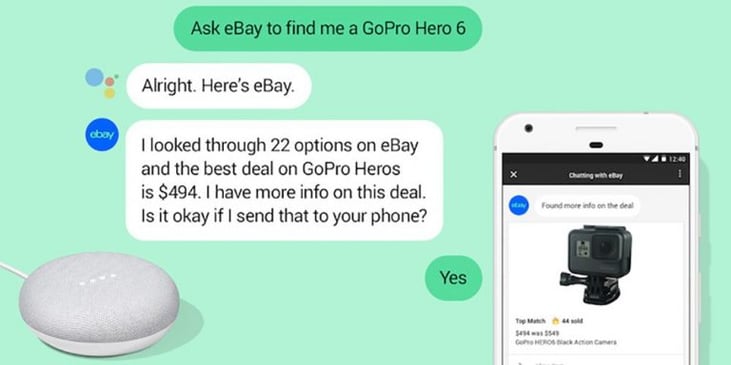
7. Lyft
Ride-sharing applications are an excellent illustration of how old services and modern technology can work together. People use technology to ask for rides from strangers and then meet up with a person who can take them to their destination.
Through its chatbot available on Facebook Messenger, Slack, and Amazon Echo, Lyft has brought a human experience back to even ride requests.
With Lyft's new Messenger integrations, people can easily ask for rides from other people while they're out and about.
You just need to tap the car icon and you’ll be matched with local drivers. The friendly Lyft Facebook messenger app lets you see when your driver is on the road, show them a photo of their vehicle's registration, and tell you which car they're going to drive.
On Slack, passengers request ride requests and trip-specific information by typing in slash commands. Just type /lyft in any channel to get a complete set of Lyft-specific keywords. You can determine ETA’s, available vehicle types, and fares all from the convenience of Slack.
By making rides even easier to get through their new app, Lyft aims to shorten the steps and simplify the process of getting a car. By adding these conversational elements, they're saving their clients' time and effort, and in turn, enhancing the client experience.
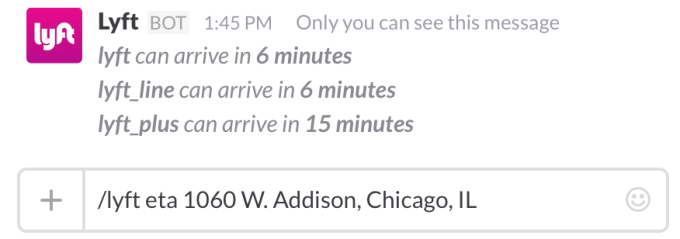
8. Domino's AnyWare
Domino's wants its customers to order their pizzas easily.
Back in 2015, Domino’s Pizza encouraged its fans to tweet or send a pizza emoji 🍕 and have one delivered to them.
With this in mind, Domino’s Pizza launched its AnyWare initiative, allowing customers to order pizzas via a variety of messaging platforms – from text messages to Facebook Messenger. Once you set up your default order, you can send Domino’s a 🍕 emoji at any time to quickly order your favourite meal.
With Domino's AnyWare, you can order your favourite items from Domino's menu using any one of several available communication channels - Google Home, Alexa, Slacker, Facebook Messenger, Twitter, or even a smart TV. This versatility and availability of different channels of communication are important to today's picky consumers, and Domino's has done everything it can to satisfy them.
Personalization and an in-depth understanding of customer's wants and desires are exactly what help Dominos' build loyalty so that its clients will return knowing that they can easily place another order, tweet, or use a keyword, as well as check up on their order and know when it will arrive.
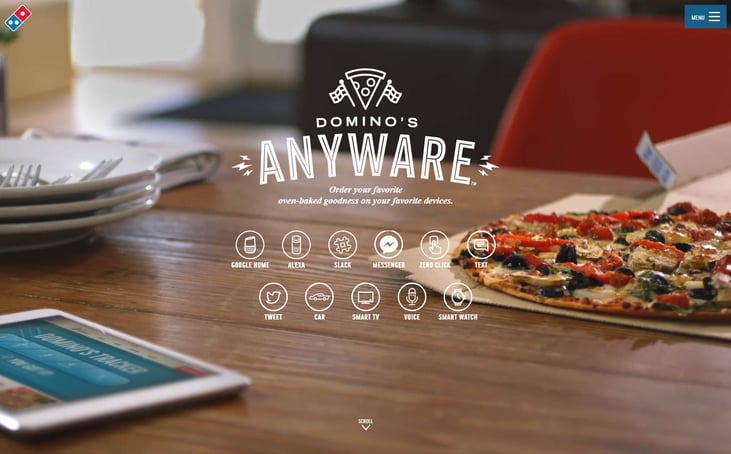
9. 1-800-Flowers
1-800-FLOWERS became one of the first companies to create a bot on Messenger.
It’s super easy, but it’s beautiful too! When you click 'Get Started' in Messenger, the app responds with two options: order flowers and talk to support.
You can then fill out your order from the window itself. It even parses an incorrect street name into the correct one. After giving your full details, you are presented with a selection of different bouquets for you to choose from.
With its simple interface, you don't ever need to worry about whether the order was placed correctly. You just click "Place Order" and everything happens automatically.
Facebook Messenger bot developers need to keep their users' attention.
Embracing the change that is conversational marketing early on allowed 1–800 Flowers to grow exponentially, reporting that 70% of the orders they receive through their bot are from new clients.
It shows that people feel increasingly comfortable interacting with bots. They're able to complete their tasks easily and efficiently, which gives them the impression that they're dealing with a real person rather than just clicking through several web pages.
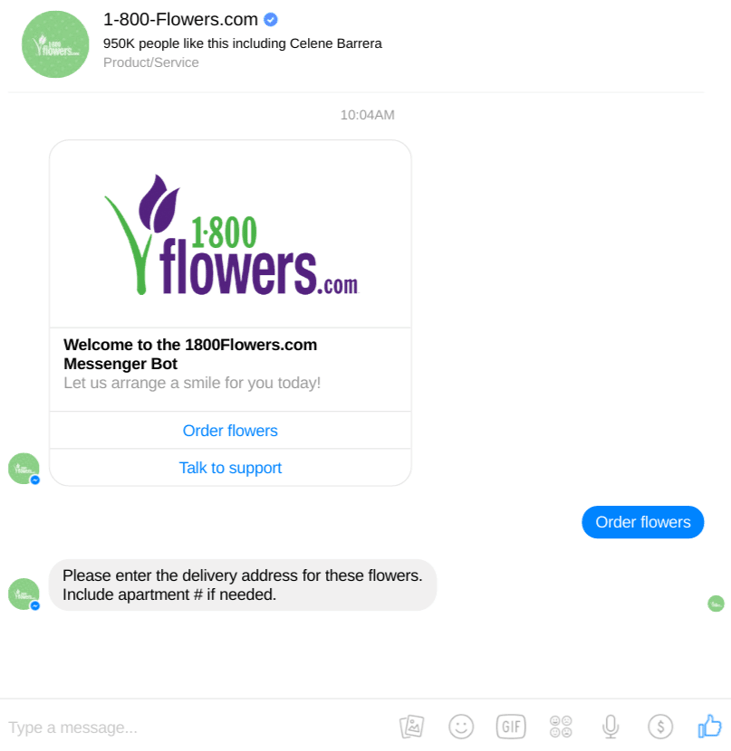
10. HelloFresh
Probably the most popular online grocery shopping service, HelloFresh has launched Freddy FreshBot as a way to help its users shop for groceries.
Through Facebook Messenger, Freddy can provide you with cooking tips, give you recipes, help you prepare meals, and even act as your personal sous chef.
HelloFresh’s new feature has been successful so far, which means they already had a good customer experience.
11. Nolah Mattress
To develop tomorrow's mattress, Nolah began by looking for ways to improve upon memory foam — an old material that is still widely used in modern mattresses. As a technology-driven business, it was important for Nolah to use the latest technologies to create a better mattress.
This mattress company found out that their prospects weren’t buying because they were seeing too many choices. They decided to narrow down the product offerings by limiting them to three choices.
They launched a live customer support tool, allowing them to provide real-time assistance to their clients. The results were impressive: an increase of 27% in their sales.
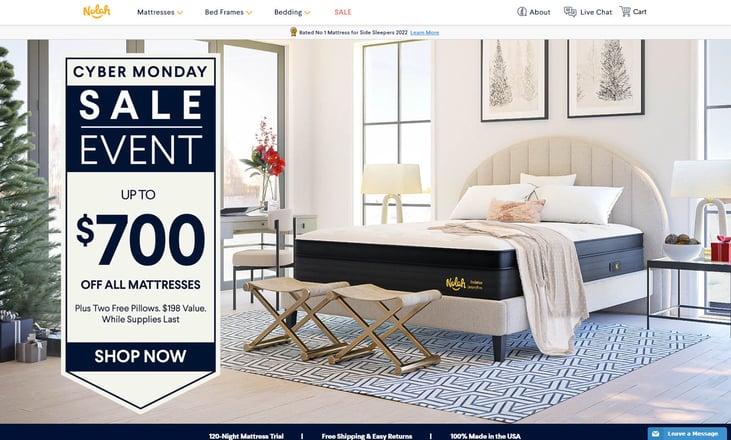
12. Nike
Social media has become an important part of conversational marketing.
Social networks give brands no choice but to react to user queries, comments, and feedback. By doing so, they allow them to proactively engage in conversation that boosts their customers’ satisfaction, improves their reputation, and appear more human and trustworthy than ever before.
For instance, take Nike as an example. The company responds to customer inquiries on Twitter by replying casually, helpfully, or personably to each buyer's question.
Interaction with followers on social media helps companies like Nike to understand their audience better and move them through the purchasing cycle.
Over time, listening to customers and interacting with them through your social media channels can help you develop a better understanding of their needs and desires.
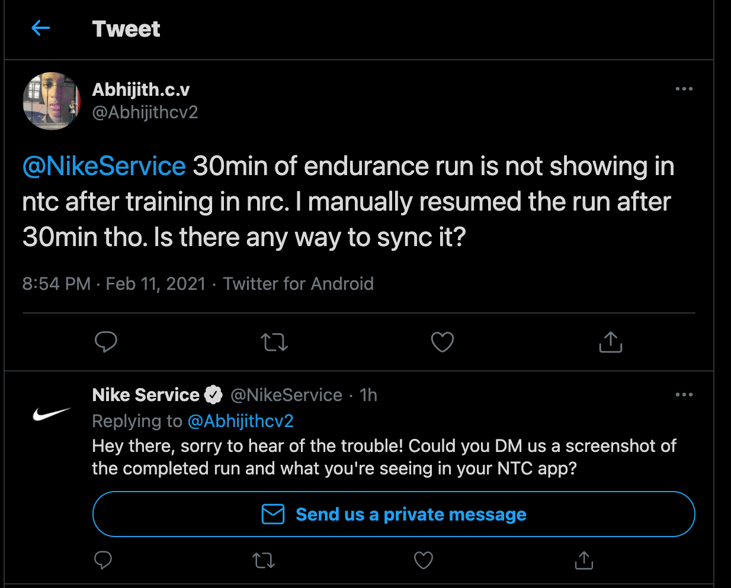
Get Started With Conversational Marketing
In conclusion, conversational marketing is a powerful tool that companies use to connect with their customers. By using these techniques, you can build relationships with your clients and increase sales without having to spend a fortune on advertising.
The key to success lies in knowing exactly who your target market is and finding creative ways to reach them. Once you know where your audience hangs out online, you can begin building trust and credibility through social media sites like Facebook and Twitter. This allows you to engage with your followers directly and create meaningful conversations that lead to increased brand awareness and sales.
With tools like Drift and the new HubSpot Conversations, businesses can field hundreds of conversations a month that wouldn't have even happened before.
At Fine Media, we believe that conversational marketing will be the future of digital marketing. It's not just for big corporations anymore - anyone can do it.
So if you're ready to get started, let us show you how.
